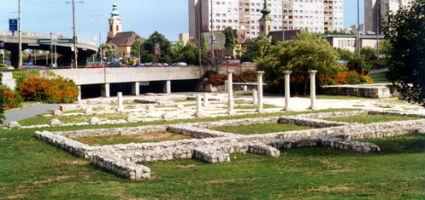2024. November 21. Thursday
Budapest History Museum - Thermae Maiores - Budapest
 |
Address: 1035, Budapest Flórián téri aluljáró
Phone number: (1) 250-1650
E-mail: aquincum@aquincum.hu
Opening hours: 01.04-31.10.: Tue-Sun 10-18
01.11-31.03.: Tue-Sun 10-16 |
Museum tickets, service costs:
|
Guide
(to pay in the Aquincum Museum)
|
1000 HUF
|
/ capita
|
|
Group guide
(1-25 people)
|
4000 HUF
|
|
|
Group guide
(over 25 people)
|
5000 HUF
|
|
|
Group guide
(over 25 people)
|
8000 HUF
|
|
|
Group guide
(1-25 people)
|
6000 HUF
|
|
|
Group guide for students
|
2100 HUF
|
|
|
Guide
(to pay in the Aquincum Museum)
|
2100 HUF
|
/ capita
|
In the centre of present Óbuda, a legion camp was set up in 89 AD. The camp existed until the 4th century. The chief of the legion counting nearly 6000 soldiers was the proconsul of Lower Pannonia from 106 AD while Aquincum became the capital of the province.
The division and delineation of the legion camp built in the 2-3 century is basically the same from the second part in the 2nd century to the 3-4th century. A new camp was built in the first part of the 4th century east from the existing one rebuilding buildings of the former camp and used for other means. The defence and road system, as well as several of the buildings were found during the excavations. Several of these are reconstructed by now, the most significant of them being the spa in the main camp.
Part of the spa was excavated by the professor István Schönvisner in 1778. The ruins found were shown to the public so they are considered the oldest founds in Hungary. In the 1900’s further excavations were performed during which additional part of the spa were discovered. The Spa Museum- Thermae Maiores opened in 1984.
The exhibition at the Spa Museum also includes information on the history of the district, focusing on the events of the past 30 years. A historic summary, chronological map, review of the most important buildings of the legion, the lifestyle of the soldiers, economy and culture are dealt with.
The division and delineation of the legion camp built in the 2-3 century is basically the same from the second part in the 2nd century to the 3-4th century. A new camp was built in the first part of the 4th century east from the existing one rebuilding buildings of the former camp and used for other means. The defence and road system, as well as several of the buildings were found during the excavations. Several of these are reconstructed by now, the most significant of them being the spa in the main camp.
Part of the spa was excavated by the professor István Schönvisner in 1778. The ruins found were shown to the public so they are considered the oldest founds in Hungary. In the 1900’s further excavations were performed during which additional part of the spa were discovered. The Spa Museum- Thermae Maiores opened in 1984.
The exhibition at the Spa Museum also includes information on the history of the district, focusing on the events of the past 30 years. A historic summary, chronological map, review of the most important buildings of the legion, the lifestyle of the soldiers, economy and culture are dealt with.